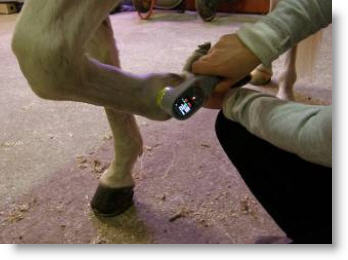Laser Therapy in Horse Treatment: A Modern Approach to Improving Equine Health
Laser treatment has actually arised as a pivotal technique in equine treatment, using concentrated light power to cultivate cellular repair work and accelerate recuperation from a selection of disorders. By stimulating mitochondrial activity and improving ATP manufacturing, laser treatment not just boosts blood circulation yet also provides substantial pain relief.
Recognizing Laser Therapy
Laser treatment, a non-invasive treatment technique, has actually acquired significant grip in equine medicine due to its efficacy in advertising healing and discomfort relief. Improved ATP levels quicken tissue repair procedures and minimize inflammation, making laser treatment particularly reliable for treating musculoskeletal injuries, injuries, and various other inflammatory conditions in horses.
There are numerous sorts of lasers used in equine treatment, each with certain wavelengths and power outputs customized to different healing needs. Low-level laser treatment (LLLT), also known as cool laser therapy, uses lower power degrees to stimulate cell feature without causing thermal damage. High-intensity laser treatment (HILT), in comparison, uses greater power levels to accomplish much deeper tissue infiltration and more substantial restorative results.
Veterinarians utilize different laser tools and methods relying on the condition being treated and the wanted depth of cells infiltration. Appropriate training and competence are crucial for making sure the safe and efficient application of laser treatment, therefore maximizing its restorative possibility while minimizing dangers.
Advantages for Horse Health
With a solid understanding of just how laser treatment works, it is essential to explore its countless advantages for equine health and wellness. By stimulating cellular feature, laser treatment promotes faster injury recovery and aids in the regrowth of broken tissues.
In addition, laser treatment has been revealed to improve flow, thereby boosting blood circulation to affected locations. Boosted circulation guarantees that vital nutrients and oxygen are delivered more efficiently, promoting the recovery process. In addition, laser therapy's anti-inflammatory results assist in reducing swelling and pain, which is important for the overall health of the equine.
Discomfort administration is another considerable advantage. By releasing endorphins and blocking pain signals, laser treatment gives reliable, non-invasive remedy for both acute and persistent pain. This can add to enhanced mobility and high quality of life for the pet.
Finally, laser treatment is a non-invasive treatment choice, minimizing the danger of problems related to more intrusive treatments. Its flexibility and efficiency make it a vital tool in contemporary equine vet medicine.
Typical Problems Treated

An additional widespread problem treated with laser treatment is joint inflammation. Steeds enduring from both intense and persistent arthritis benefit from the anti-inflammatory effects of laser treatment, which helps to reduce pain and improve joint feature. In addition, laser therapy is utilized in the management of wounds. Whether dealing with surgical lacerations or stressful injuries, the method advertises quicker tissue repair and reduces the risk of infection.
Horse breathing problems, such as persistent airway obstruction (RAO), likewise respond positively to laser therapy. Laser treatment is advantageous in dealing see with hoof issues, consisting of laminitis and abscesses.
Procedure and Security
Executing laser treatment in equine treatment includes a thorough procedure to make sure both efficacy and security. Equine Therapy. The procedure begins with a thorough veterinary analysis to determine the suitability of laser treatment for the steed's particular condition. As soon as deemed suitable, the therapy area is prepared by cleaning and, if needed, clipping the hair to boost laser infiltration
The specialist needs to pick the correct kind of laser, generally a low-level laser (LLLT) or a high-power laser (HPL), relying on the problem being dealt with. The laser device is then calibrated to the proper wavelength, power, and period setups. Throughout the application, the expert moves the laser over the targeted area in a methodical fashion, making certain consistent and even exposure.
Safety protocols are strictly stuck to, including making use visite site of safety glasses for both the expert and the steed. In addition, it is crucial to monitor the horse for any indicators of discomfort or unfavorable reactions throughout the procedure. Post-treatment, the horse is often given a duration of remainder to permit the healing effects to show up.

Future of Horse Laser Treatment
As advancements in veterinary medication proceed to unfold, the future of equine laser treatment holds substantial pledge. Emerging technologies and much deeper scientific insights are established to fine-tune and expand the applications of laser treatment for horses. Among one of the most anticipated more tips here growths is the assimilation of sophisticated imaging techniques that permit much more precise targeting of damaged tissues, thereby improving therapeutic outcomes. Additionally, the development of portable and user-friendly laser tools is most likely to make this therapy a lot more accessible to a broader variety of practitioners and equine owners.
Moreover, continuous research into the molecular and mobile mechanisms of laser therapy will likely generate optimized protocols tailored to details conditions, boosting effectiveness and reducing therapy times. Personalized treatment plans based on genetic and biochemical markers can come true, ensuring that each equine obtains the most ideal and effective care.
Moreover, governing developments and standardization of procedures will certainly boost the reliability and dependability of laser therapy in equine practice. Equine Therapy. As these advancements remain to arise, equine laser treatment is positioned to come to be an important element of vet treatment, offering boosted recovery and improved quality of life for horses worldwide
Final Thought

Comments on “Equine Therapy Success Stories: Real Individuals, Actual Psychological Makeovers”